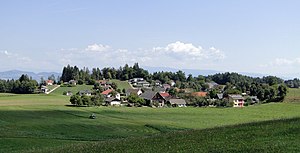Tutzach
|
Tutzach / Tulce ( village ) locality |
||
|---|---|---|
|
|
||
| Basic data | ||
| Pole. District , state | Klagenfurt-Land (KL), Carinthia | |
| Judicial district | Klagenfurt | |
| Pole. local community | Ebenthal in Carinthia ( KG Radsberg ) | |
| Coordinates | 46 ° 35 '15 " N , 14 ° 22' 44" E | |
| Residents of the village | 122 (January 1, 2020) | |
| Building status | 37 (2001) | |
| Statistical identification | ||
| Locality code | 00991 | |
| Counting district / district | Radsberg (20402 003) | |
 Tutzach - Tuce: district south of the Radsberger Landesstraße |
||
| Source: STAT : index of places ; BEV : GEONAM ; KAGIS | ||
The village of Tutzach ( Slovenian : Tuce ) is located in the market town of Ebenthal in Carinthia with 122 inhabitants (as of January 1, 2020).
geography
The village and fields lie on the largely flat area of Tutzach-Werouzach at 750 m above sea level. In the north, east and south they surround large forests, in the west the corridor connects to the scattered settlement village Lipizach.
history
In the time that followed in Central Europe through the turmoil of the interregnum , in Carinthia above all through the death of Duke Ulrich von Spanheim (1269), the Přemysl Ottokar and finally through the Imperial War of Rudolf von Habsburg, who was appointed German king, against the Bohemian King is characterized, Tutzach is also mentioned for the first time. In 1270 Engelbert von Printinhav (Breitenau in Lower Carniola) and Friedrich, son of Hermann von Tutzach ("Hermann de Tulz") give the Viktring 11 Huben in Tutzach (later there is talk of 9 Huben) and 1 in black and received from the monastery 10 Huben in Carniola .
This means that an Engelbert von Printinhav was wealthy in Tutzach and partly also in Schwarz, who obviously exchanged the for him remote property in Tutzach for properties in Lower Carniola that were closer to him. However, the aforementioned Hermann von Tulz and his son Friedrich may have been “villici”, i.e. Meier, ordered by Engelbert, who supervised the farmers in this remote part and carried out the will of the master.
With this exchange, Viktring acquired almost all of Tutzach. In 1289 it was able to acquire another hat in Tulz and one in black through donations. At that time Konrad von Grafenstein gave the Viktring monastery a Hube in Tutzach and 1 ½ Huben “in Hofulingen” (Höflein = black) and one in Angern to “improve the monks' diet on certain days”. Thus from 1289 Viktring owned 10 hubs in Tutzach of the total of 13 hubs mentioned at that time. Tutzach thus belonged to the Viktring monastery. They came to the neighboring Greifenfels Castle - probably around 1530 when the country's monasteries had to make heavy sacrifices to finance the defense against the Turks. While the land register from 1529 still shows 10 hubs owned by Viktring, a few decades later we find 11 hubs and 1 chaste tree belonging to Greifenfels in the land register from 1586 in Tutzach. In addition there are 2 Freiholden who only had to pay free money to Greifenfels. Thus, between 1529 and 1586, Viktring must have essentially lost its property in Tutzach to the rule of Greifenfels .
economy
In 1970 there were eleven farms in Tutzach, five of which were part-time businesses. The agricultural holdings had an area between 8 and 29 ha. In most of the holdings, the forest covered more than 60% of the agricultural and forestry usable area (LFN). For centuries, therefore, the logging of firewood and the sale in Klagenfurt as additional income played a major role.
On the largely flat plateau there is mainly arable land, with winter rye, spring barley, oats and late potatoes. Grassland management was mostly carried out in the form of Egartwirtschaft as alternating meadows, that is, alternating multi-year meadow land with arable land. Livestock farming, especially beef fattening and dairy cow farming, were the most important sources of income. Extra-agricultural sideline, mainly through work in the Klagenfurt area. In Tutzach itself there was only an inn and a blacksmith who shod the horses in 1973. Since about 1880 seven chaste had settled in the village . They only owned 0.5–1.0 ha of arable land. Most of the time it was a question of reluctant heirs who were settled with land.
literature
- Klaus Arnold: The eastern Sattnitz. The problem of a stagnating agricultural area in the outskirts of Klagenfurt. Diss. From the University of Vienna, 2 vol., Vol. 131/1 and 2, Association of Austrian Scientific Societies, Vienna 1976
- Klaus Arnold: The eastern Sattnitz - mountain farming area at the gates of Klagenfurt . Amaliendorf 2012. CD and online access at arnold-research.eu
Web links
Individual evidence

